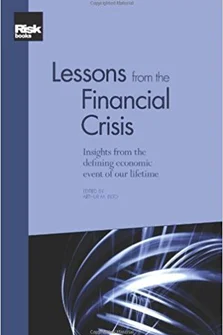The Martingale Theory of Bubbles: Implications for the Valuation of Derivatives and Detecting Bubbles
Robert A Jarrow and Philip Protter
Introduction to 'Lessons from the Financial Crisis'
The Credit Crunch of 2007: What Went Wrong? Why? What Lessons Can be Learned?
Underwriting versus Economy: A New Approach to Decomposing Mortgage Losses
The Shadow Banking System and Hyman Minsky’s Economic Journey
The Collapse of the Icelandic Banking System
The Quant Crunch Experience and the Future of Quantitative Investing
No Margin for Error: The Impact of the Credit Crisis on Derivatives Markets
The Re-Emergence of Distressed Exchanges in Corporate Restructurings
Modelling Systemic and Sovereign Risks
Measuring and Managing Risk in Innovative Financial Instruments
Forecasting Extreme Risk of Equity Portfolios with Fundamental Factors
Limits of Implied Credit Correlation Metrics Before and During the Crisis
Another view on the pricing of MBSs, CMOs and CDOs of ABS
Pricing of Credit Derivatives with and without Counterparty and Collateral Adjustments
A Practical Guide to Monte Carlo CVA
The Endogenous Dynamics of Markets: Price Impact, Feedback Loops and Instabilities
Market Panics: Correlation Dynamics, Dispersion and Tails
Financial Complexity and Systemic Stability in Trading Markets
The Martingale Theory of Bubbles: Implications for the Valuation of Derivatives and Detecting Bubbles
Managing through a Crisis: Practical Insights and Lessons Learned for Quantitatively Managed Equity Portfolios
Active Risk Management: A Credit Investor’s Perspective
Investment Strategy Returns: Volatility, Asymmetry, Fat Tails and the Nature of Alpha
After the 2007–9 credit crisis, caused by a crash in housing prices (the bursting of an alleged housing price bubble), asset price bubbles received considerable attention in the financial press and regulatory arena.11 See William Dudley, “Asset Bubbles and the Implications for Central Bank Policy”, speech, April 7, 2010 (available at http://www.ny.frb.org). Before this episode, however, the modelling of asset price bubbles had a long history in economics.
Classical economics studied the existence and characterisation of bubbles in discrete-time, infinite- and finite-horizon, equilibrium models. It has been shown that bubbles cannot exist in finite-horizon rational expectation models (Santos and Woodford 1997; Tirole 1982). They can arise, however, in markets where traders behave myopically (Tirole 1982), where there are irrational traders (De Long et al 1990), in infinite-horizon growing economies with rational traders (O’Connell and Zeldes 1988; Tirole 1985; Weil 1990), economies where rational traders have differential beliefs and when arbitrageurs cannot synchronise trades (Abreu and Brunnermeier 2003) or when there are short-sale/borrowing constraints (Santos and Woodford
Copyright Infopro Digital Limited. All rights reserved.
As outlined in our terms and conditions, https://www.infopro-digital.com/terms-and-conditions/subscriptions/ (point 2.4), printing is limited to a single copy.
If you would like to purchase additional rights please email info@risk.net
Copyright Infopro Digital Limited. All rights reserved.
You may share this content using our article tools. As outlined in our terms and conditions, https://www.infopro-digital.com/terms-and-conditions/subscriptions/ (clause 2.4), an Authorised User may only make one copy of the materials for their own personal use. You must also comply with the restrictions in clause 2.5.
If you would like to purchase additional rights please email info@risk.net










